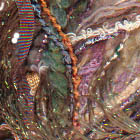

I finished one of the projects from the first lesson of Sue B.'s Mixed Media class at Joggles.
This is the "Pattern Tissue Surface" made into a "Sewer's Notebook."
It is successive layers of Muslin +Misty Fuse + Torn Pattern Tissue + Misty Fuse + Tissue (again) + Glimmer Mist + walnut ink (for color)
I'm a true convert to Misty Fuse now. I used to always use Steam-a-Seam Lite 2. But even that can build up and get stiff with successive layers. Missty Fuse stays soft and supple even with multiple layers. I'll have to get some more ...
For the color, I watered down a little Terra Cotta walnut ink, and then a layer of Glimmer Mist Rose Tea to make it a little pinker.
The project was to turn our composed fabric into a notebook. The Pattern Tissue Paper Fabric was fused to a base of wool felt, then topped with a gold sparkley tulle with a few sequins trapped underneath. (I tried black tulle, but it just didn't make the piece SING. It's kind of hard to see it in the picture, but it makes a difference.
I just put in the signatures (the paper). That was not nearly as difficult as I thought it might be ... Poking the holes with an awl first was a smart idea.
As a Librarian (by day), bookbinding has long appealed to me. Although I've repaired many a book, this is the first one I've made from scratch. I'm really pleased with it!
The pattern tissue paper fabric is nicer than I expected. It looks old-timey and antique, but it has a soft, almost leathery feel. It's full of body, too, with the support of the wool felt base. I know that Sue B., the instructor is working on a journal-making class for next fall. I'm very interested in doing more of this!
Now to figure out how to post my results to the class ...

































